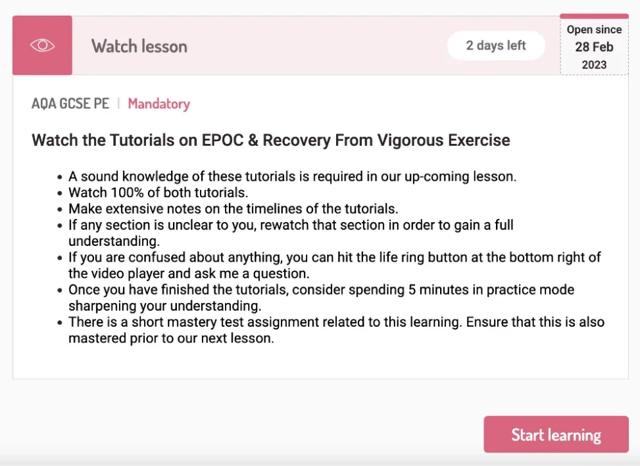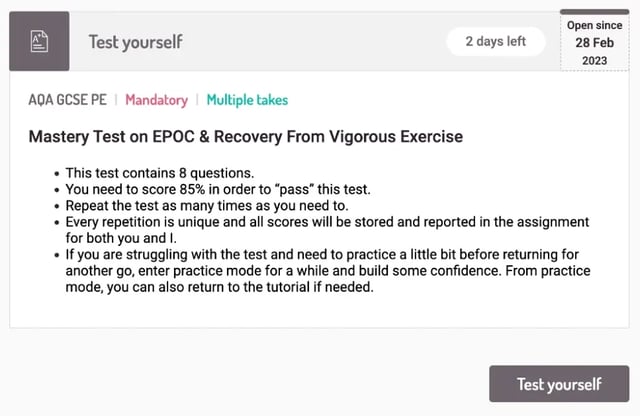Assignment Wizardry! Setting PE Homework and Class work for Impact - Part 1
In a recent meeting with my colleague Elle Houghton, Elle pointed out to me that the blog could be used for more than just me spouting on about PE (these weren’t the words she used). Elle suggested that the blog could be a really useful vehicle for me to provide insight to the over 1,000 PE departments which currently use TheEverLearner.com as customers regarding the best use of the platform.
Even if you are not a customer, these tips might be useful to you as they are based on sound pedagogical and cognitive science principles. Many of the ideas can be applied in your own context whether you use TheEverLearner.com or not. However, I will use the language of The EverLearner throughout this post for clarity.
In addition to this blog post, I am also hosting a LIVE webinar on Monday 6th March 2023 at 16:00 (GMT) in which I will go through these tips in more detail. It would be great to see you there!
Don't forget to register for notifications:
So, here are the first five of 10 tips about how to set assignments to PE students.
10 top assignment tips
In this post:
- Establish a pattern.
- Make assignment descriptions hyper-accurate.
- Interleave old and new learning with structure.
- Test for mastery.
- Keep assignments “skinny”.
- Examine for skills, not just content.
- Use hard deadlines.
- Reassign when you need to.
- Set in-class tasks.
- Blend homework and classwork together.
Top assignment tip #1: Establish a pattern.
Regularity and predictability increase assignment completion rates. It really is that simple. My first tip is to set your assignments to achieve regularity and predictability (of expectation).
You will find below a weekly model for the assignments that I set for one group. My point is not that you should copy it but that the ongoing nature of these weekly assignments helps my students to respond to them because they can be built into the students’ weekly structures.
 View of all of Fleur’s weekly assignments
View of all of Fleur’s weekly assignments

View of Fleur’s pre-lesson learning. This is so Fleur can work with this knowledge in our Friday lesson.

View of Fleur’s pre-lesson micro-mastery test to prove she understands the core ideas.
 View of Fleur’s weekly whole course test. She will complete this once every week for 52 weeks of Year 10.
View of Fleur’s weekly whole course test. She will complete this once every week for 52 weeks of Year 10.
 View of Fleur’s post-lesson test. This will open once our Friday lesson ends and requires Fleur to reactivate her new learning shortly after the learning episode. This helps to delay forgetting.
View of Fleur’s post-lesson test. This will open once our Friday lesson ends and requires Fleur to reactivate her new learning shortly after the learning episode. This helps to delay forgetting.
Look closely at the model. If I were to structure my students’ tasks regularly with this type of arrangement, their tendency to expect what is coming will increase. Their confidence and familiarity with the site would increase massively. The data I had on their performances in every lesson of the course would be honed and relevant.
I also value a change-up and you may want to have weeks where you switch the ways you do things. You may have an assessment week when you build in more summative work or, during mocks, you limit your assigned work down to one or two assignments rather than three or four. However, I strongly encourage you to build regularity into your assignment setting.
Where possible, try to set your assignments in the same free period each week, say. The reason that this helps is that when you set an assignment, this triggers notifications to the students. If your students are accustomed to them arriving on a Monday morning during Period 1, say, they will become accustomed to checking in with their work. A further benefit to this model is that there is no class time given over to the mechanics of homework setting. Homework setting and recording can take chunks of time out of class time and the model described here preserves class time for classwork.
Top assignment tip #2: Make assignment descriptions hyper-accurate.
I am a strong believer in the “principle of zero-wriggle-room”. Whilst I will never write this phrase down on any document or procedure (other than here), it is my mentality when approaching student learning and expectations. I apply the principle in all kinds of ways but here, in this tip, I want to focus on how I make my assignment description very clear to the student recipients so that there is “zero-wriggle-room”. In other words, what I expect of the student is objective and shared.
If you like these descriptions and you wish to use them as snippets, you can download this editable snippet document (you will be asked to sign in with a valid Google account to make a copy) with all the text contained and simply copy and paste them into your own assignments. This will also save you a little bit of time. 😇
 Click to make your own copy - you will need a valid Google account
Click to make your own copy - you will need a valid Google account
The snippets are not aimed at being exhaustive and I would be really keen to read the ideas of others. This is why the document is editable. But, in all cases, I am expressing exactly what I expect of the student taking the assignment. This means that, when students follow my guidelines, we can celebrate success. It also means that, when students struggle to follow my guidelines, I can identify and challenge this behaviour.
You may have noticed that a number of my assignments are mastery-based. Let’s say I set a standard of 80% for a quiz test. If a student tries really hard at this task and only achieves 60% over four attempts, say, I am not going to punish this outcome. Rather, this is clear evidence that this student needs support to reach the appropriate level.
Top assignment tip #3: Interleave old and new learning with structure.
Interleaving is the process of arranging material in a non-contiguous manner. In education, interleaving can be done very formally but, by many teachers, is often a more informal process. For example, if I am teaching about articulations (joints) in the early lessons of GCSE or A-level PE, it is inevitable that I will “interleave forwards” and teach elements of lever systems or planes or axes. To me, this is simply “good teaching”.
But I want to be specific here: I am recommending that throughout a student’s experience of a PE course, they are set assignments that contain interleaved practice.
Interleaved practice has the following characteristics:
- Questions are presented from more than one topic.
- The topics that are interleaved are potentially “confusable”. For example, we might interleave the double-loop circulatory system with gaseous exchange. But we would not interleave the double-loop circulatory system with *positive and negatives of commercialisation, say.
- Questions are presented from more than one skill command (in exam style).
- The skills that are interleaved are potentially confusable. For example, we might specifically interleave the ”describe” and “explain” commands, as they are easily confused. We are less likely to specifically interleave “define” and “evaluate”, as the differences between them are very stark.
*Some courses such as AQA GCSE and AQA A-level PE do allow and even expect students to be able to make links between widely varying themes. This forms part of the synoptic assessment of those courses.
The benefits of interleaving old and new learning are as follows:
- Causes the student to use “discriminative contrast”. This means the student needs to accurately interpret the exact meaning of the question and which topic it refers to.
- Causes better retention over time. The Rohrer 2012 research, reported here by the MetaLearners suggests that interleaved practice can cause up to 74% better retention over 30 days.
- Can cause the spacing advantage. Spacing has long been known to cause a positive impact on knowledge retention. Likewise, repeated reactivation of old learning helps to delay forgetting.
- Increases the tendency for the student to develop comparative and contrast skills.
- Can be used to diagnose where students are forgetting concepts more or less.
In essence, if we interleave the right knowledge and skills in practice at the right times, students will experience “desirable difficulty”. Desirable difficulty can be the vehicle for students to better encode ideas. Furthermore, by repeatedly interleaving older learning with new learning, students have to retain knowledge over time and the forgetting cycle is delayed.
So, how do we actually do it? Take a look at these two examples. One if of a 20-question-quiz which is sat once every week but with an ever-increasing range of topic areas but, crucially, also different quiz questions every trial. The second is a practice exam where students need to discriminate between the skills of describing and explaining.
 The 14th of a series of 52 weekly, whole course so far tests.
The 14th of a series of 52 weekly, whole course so far tests.
 Image of the holding screen for a practice exam based on the describe and explain skills in AQA GCSE PE.
Image of the holding screen for a practice exam based on the describe and explain skills in AQA GCSE PE.
Many other examples could be given and I urge teachers to use your own examples of interleaving and share them with me. 🙂
Top assignment tip #4: Test for mastery.
Mastery is the right of every student in my classroom. I’m going to state that again:
"Mastery is the right of every student in my classroom."
What this means in practice is the following:
- I never attempt to judge what a student’s learning potential is.
- I never set arbitrary limits on a student’s performance such as a differentiated task.
- I never set a mastery task with a specific time limit. In other words, I allow a variable seat-time for a fixed achievement rate (mastery).
- All mastery tasks are repeatable.
So, this is my standard. Therefore, I set mastery tasks commonly. Mastery tasks, in my context, have the following characteristics:
- Variable seat-time.
- Opportunity to repeat.
- Timescale that allows for comfortable repetition.
- Mastery defined as 85% success rate minimum.
So, what does this look like in practice? Let’s say, for example, that I have set students some preloading/flipped learning homework assignments. Perhaps I have set a tutorial to be watched and an eight-question-test to demonstrate clear understanding of the new concepts. In this concept, I will always expect the students to master the eight-question-test or to keep attempting until they do. Take a look below:


Students can repeat the test as many times as they need to. They can return to the tutorial if they need to. They can move to practice mode if they need to. The only ingredients that are required by the student are the following:
- Time management to allow them the space to repeat where necessary.
- Resilience and determination to achieve the standard.
These behaviours are controllable by the student. Moreover, the student realises that I have belief in them and their capacity to achieve the mastery standard. Finally, if a student is struggling whilst trying hard, I am there to support them at any moment with full transparency of their hard work and determination.
If we see this from the student’s perspective, this is really valuable. A student might think to themselves:
- This is hard!
But I guarantee they will also think:
- My teacher believes in me.
- He/she/they are there to help me.
- I have lots of resources available if I’m struggling.
- This outcome is in my control.
- Even if I don’t get the standard but I try really hard, my teacher is going to know about my efforts and will help me get to the level.
Isn’t this how education should be? Isn’t this the way that human beings learn and master things? Isn’t this the belief we should have for and show our learners? Isn’t this what an educator does day in, day out?
Top assignment tip #5: Keep assignments “skinny”.
This is a super simple point and world hand in hand with tip #4 about mastery: make your assignments “skinny assignments”. In other words, set bite-size, manageable chunks that can be repeated quickly and without the tendency to walk away.
So, let’s use an example. You might want your students to complete in the region of 20 quiz questions on the components of the blood. The best way to do this is to set them a 30-question quiz, right? Wrong! I am far more likely to set a quiz of between eight and 12 questions and, in association, set a mastery standard of 85%.
Let’s say that I set a 10-question quiz and the standard is 85%. In reality, to pass this test, the student must achieve 9/10 (sneaky, right!?) correct answers. To achieve this, some students will nail it first time but the majority will take two to three attempts to get the level. In this case, students, on average, will answer more questions, provide more diagnostic feedback and have the sense of working towards a high standard compared to me simply setting a 20-question quiz.
Furthermore, should I set a 20-question mastery quiz, the tendency to repeat the quiz (with new content) decreases because each run takes a greater chunk of time. We need to keep things “skinny” to get the behaviours that we want from learners.
So, there we have it. Five tips for making brilliant assignments. In Part 2, I will cover five more tips. Some of those go into deeper learning theory but all are specific to the teaching and learning of qualification-based physical education.
Thank you for reading and have a wonderful day and don't forget - Monday 6th March 2023 - see you there!
%20Text%20(Violet).png)


.png)

